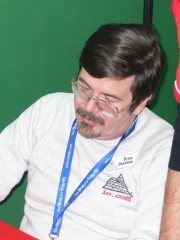







The Most Famous
GAME DESIGNERS from United States
This page contains a list of the greatest American Game Designers. The pantheon dataset contains 77 Game Designers, 35 of which were born in United States. This makes United States the birth place of the most number of Game Designers.
Top 10
The following people are considered by Pantheon to be the top 10 most legendary American Game Designers of all time. This list of famous American Game Designers is sorted by HPI (Historical Popularity Index), a metric that aggregates information on a biography's online popularity. Visit the rankings page to view the entire list of American Game Designers.

1. Gary Gygax (1938 - 2008)
With an HPI of 70.11, Gary Gygax is the most famous American Game Designer. His biography has been translated into 31 different languages on wikipedia.
Ernest Gary Gygax ( GHY-gaks; July 27, 1938 – March 4, 2008) was an American game designer and author best known for co-creating the pioneering tabletop role-playing game Dungeons & Dragons (D&D) with Dave Arneson. In the 1960s, Gygax created an organization of wargaming clubs and founded the Gen Con tabletop game convention. In 1971, he co-developed Chainmail, a miniatures wargame based on medieval warfare with Jeff Perren. He co-founded the company TSR (originally Tactical Studies Rules) with childhood friend Don Kaye in 1973. The next year, TSR published D&D, created by Gygax and Arneson the year before. In 1976, he founded The Dragon, a magazine based around the new game. In 1977, he began developing a more comprehensive version of the game called Advanced Dungeons & Dragons. He designed numerous manuals for the game system, as well as several pre-packaged adventures called "modules" that gave a person running a D&D game (the "Dungeon Master") a rough script and ideas. In 1983, he worked to license the D&D product line into the successful D&D cartoon series. Gygax left TSR in 1986 over conflicts with its new majority owner, but he continued to create role-playing game titles independently, beginning with the multi-genre Dangerous Journeys in 1992. He designed the Lejendary Adventure gaming system, released in 1999. In 2005, he was involved in the Castles & Crusades role-playing game, which was conceived as a hybrid between the third edition of D&D and the original version of the game. In 2004, he had two strokes and narrowly avoided a subsequent heart attack; he was then diagnosed with an abdominal aortic aneurysm and died in March 2008 at age 69. Following Gygax's funeral, many mourners formed an impromptu game event which became known as Gary Con 0, and gamers celebrate in Lake Geneva each March with a large role-playing game convention in Gygax's honor.

2. Lizzie Magie (1866 - 1948)
With an HPI of 68.97, Lizzie Magie is the 2nd most famous American Game Designer. Her biography has been translated into 31 different languages.
Elizabeth J. Magie Phillips (née Magie; May 9, 1866 – March 2, 1948) was an American game designer, writer, feminist, and Georgist. She invented The Landlord's Game, the precursor to Monopoly, to illustrate teachings of the progressive era economist Henry George.

3. Jeff Kinney (b. 1971)
With an HPI of 64.46, Jeff Kinney is the 3rd most famous American Game Designer. His biography has been translated into 43 different languages.
Jeffrey Patrick Kinney (born February 19, 1971) is an American author and illustrator. He is best known for creating, writing and illustrating the children's book series Diary of a Wimpy Kid. He also created the child-oriented website Poptropica.

4. Gabe Newell (b. 1962)
With an HPI of 63.16, Gabe Newell is the 4th most famous American Game Designer. His biography has been translated into 56 different languages.
Gabe Logan Newell (born November 3, 1962), also known by his nickname GabeN, is an American video game developer and businessman. He is the co-founder, president and majority owner of the video game company Valve Corporation. Newell was born in Colorado and grew up in Davis, California. He attended Harvard University in the early 1980s but dropped out to join Microsoft, where he helped create the first versions of the Windows operating system. In 1996, he and Mike Harrington left Microsoft to found Valve and fund the development of their first game, Half-Life (1998). Harrington sold his stake in Valve to Newell and left in 2000. Newell led the development of Valve's digital distribution service, Steam, which launched in 2003 and controlled most of the market for downloaded PC games by 2011. As of 2021, Newell owned at least one quarter of Valve; Forbes estimated that he owned at least half as of 2025. He is also the owner of the marine research organization Inkfish, the neuroscience company Starfish Neuroscience, and the custom yacht manufacturer Oceanco. Newell has been estimated as one of the wealthiest people in the United States and the wealthiest person in the video games industry, with an estimated net worth of $11 billion as of 2025.

5. John Carmack (b. 1970)
With an HPI of 62.89, John Carmack is the 5th most famous American Game Designer. His biography has been translated into 37 different languages.
John D. Carmack II (born August 21, 1970) is an American computer programmer and video game developer. He co-founded the video game company id Software and was the lead programmer of its 1990s games Commander Keen, Wolfenstein 3D, Doom, Quake, and their sequels. Carmack made innovations in 3D computer graphics, such as his Carmack's Reverse algorithm for shadow volumes. In 2013, he resigned from id Software to work full-time at Oculus VR as their CTO. In 2019, he reduced his role to Consulting CTO so he could allocate more time toward artificial general intelligence (AGI). In 2022, he left Oculus to work on his AGI startup, Keen Technologies.

6. Todd Howard (b. 1971)
With an HPI of 60.30, Todd Howard is the 6th most famous American Game Designer. His biography has been translated into 29 different languages.
Todd Andrew Howard (born 1970) is an American video game designer, director, and producer. He serves as director and executive producer at Bethesda Game Studios, where he has led the development of the Fallout and The Elder Scrolls series. He was also the game director for Starfield.

7. Steve Jackson (b. 1953)
With an HPI of 59.69, Steve Jackson is the 7th most famous American Game Designer. Her biography has been translated into 18 different languages.
Steve Jackson (born 1953) is an American game designer whose creations include the role-playing game GURPS and the card game Munchkin.

8. Carol Shaw (b. 1955)
With an HPI of 55.84, Carol Shaw is the 8th most famous American Game Designer. Her biography has been translated into 22 different languages.
Carol Shaw (born 1955) is an American video game designer. She is best known for creating the Atari 2600 vertically scrolling shooter game River Raid (1982) for Activision. She worked for Atari, Inc. from 1978 to 1980, where she designed multiple games including 3-D Tic-Tac-Toe (1978) and Video Checkers (1980), both for the Atari VCS before it was renamed to the 2600. She left game development in 1984 and retired in 1990.

9. Will Wright (b. 1960)
With an HPI of 55.75, Will Wright is the 9th most famous American Game Designer. His biography has been translated into 32 different languages.
William Ralph Wright (born January 20, 1960) is an American video game designer and co-founder of the game development company Maxis, which later became part of Electronic Arts. In April 2009, he left EA to run Stupid Fun Club Camp, an entertainment think tank in which Wright and EA are principal shareholders. The first computer game Wright designed was Raid on Bungeling Bay in 1984, but it was SimCity that brought him to prominence. The game was published by Maxis, which Wright co-formed with Jeff Braun. Wright continued to innovate on the game's central theme of simulation with numerous other titles including SimEarth and SimAnt. Wright has earned many awards for his work in game design. He is best known for being the original designer of The Sims series, of which Maxis developed the first entry in 2000. The game spawned multiple sequels, including The Sims 2, The Sims 3, The Sims 4 and their expansion packs. His latest work, Spore, released in September 2008 and features gameplay based upon the model of evolution and scientific advancement. The game sold 406,000 copies within three weeks of its release. In 2007, he became the first game designer to receive the BAFTA Fellowship, which had previously only been presented to those in the film and television industries.

10. Roberta Williams (b. 1953)
With an HPI of 54.43, Roberta Williams is the 10th most famous American Game Designer. Her biography has been translated into 27 different languages.
Roberta Lynn Williams (née Heuer; born February 16, 1953) is an American video game designer and writer. She has been named by several publications as one of the best or most influential creators in the video game industry. Williams co-founded Sierra On-Line with her husband, game developer Ken Williams. In 1980, her first game, Mystery House, became a modest commercial success; it is credited as the first graphic adventure game. She then became known for creating and maintaining the King's Quest series, as well as designing the full motion video game Phantasmagoria in 1995. Sierra was acquired by CUC International in 1996, leading to layoffs and management changes. Williams took a brief sabbatical, and returned to the company in a game design role, but grew increasingly frustrated with CUC's creative and business decisions. After the release of King's Quest: Mask of Eternity in 1998, Williams left the game industry in 1999 and focused her retirement on traveling and writing historical fiction. She has since released her historical novel Farewell to Tara in 2021, and returned to game development with the 3D remake of the classic adventure game Colossal Cave Adventure, released as Colossal Cave in 2023. Several publications have called Roberta Williams the "Queen of adventure games" for co-founding Sierra, pioneering the graphic adventure game genre, and creating the King's Quest series. She has received the Industry Icon Award from The Game Awards, and the Pioneer Award at the Game Developers Choice Awards.
People
Pantheon has 35 people classified as American game designers born between 1866 and 1978. Of these 35, 31 (88.57%) of them are still alive today. The most famous living American game designers include Jeff Kinney, Gabe Newell, and John Carmack. The most famous deceased American game designers include Gary Gygax, Lizzie Magie, and Dave Arneson. As of April 2024, 6 new American game designers have been added to Pantheon including Rebecca Heineman, Chris Avellone, and Cory Barlog.
Living American Game Designers
Go to all RankingsJeff Kinney
1971 - Present
HPI: 64.46
Gabe Newell
1962 - Present
HPI: 63.16
John Carmack
1970 - Present
HPI: 62.89
Todd Howard
1971 - Present
HPI: 60.30
Steve Jackson
1953 - Present
HPI: 59.69
Carol Shaw
1955 - Present
HPI: 55.84
Will Wright
1960 - Present
HPI: 55.75
Roberta Williams
1953 - Present
HPI: 54.43
John Romero
1967 - Present
HPI: 53.69
Jeff Kaplan
1972 - Present
HPI: 51.32
Scott Cawthon
1971 - Present
HPI: 50.60
Ron Gilbert
1964 - Present
HPI: 50.34
Deceased American Game Designers
Go to all RankingsGary Gygax
1938 - 2008
HPI: 70.11
Lizzie Magie
1866 - 1948
HPI: 68.97
Dave Arneson
1947 - 2009
HPI: 52.85
Rebecca Heineman
1963 - 2025
HPI: 44.66
Newly Added American Game Designers (2025)
Go to all RankingsRebecca Heineman
1963 - 2025
HPI: 44.66
Chris Avellone
1971 - Present
HPI: 43.91
Cory Barlog
1975 - Present
HPI: 41.49
Jane Jensen
1963 - Present
HPI: 41.03
Robyn Miller
1966 - Present
HPI: 35.03
Josh Sawyer
1975 - Present
HPI: 34.78
Overlapping Lives
Which Game Designers were alive at the same time? This visualization shows the lifespans of the 4 most globally memorable Game Designers since 1700.












